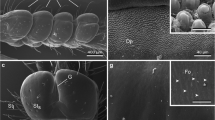Summary
It is shown that the adhesion promoting fluid in insects is an oily secretion not miscible with water, which stains with fatsoluble stains. Staining experiments revealed that inMusca domestica L. this fluid is probably secreted in an integumental fold near the basis of the pretarsal adhesive pads (pulvilli). It flows in a system of grooves on the upper side of the pulvilli to the periphery, and from there to the adhesive spots on the under side of the pulvilli. Scanning electron micrographs illustrating this system are given. A similar situation is likewise found in other insects with adhesive pads. Histological examination of the presumed secreting areas failed to detect dermal gland ducts, the fluid obviously being secreted through the cuticle, as is generally the case in the lipid secreting integument of insects. In addition it is shown that the waterproofing cuticular layer (“wax layer”) is so fluid in vivo that it can act as an adhesion promoting fluid. Adhesion fluid in insects might thus be interpreted as part of the general cuticular lipid layer.
Zusammenfassung
Es wird gezeigt, daß die Adhäsionsflüssigkeit der Insekten ein mit Wasser nicht mischbares, öliges Sekret ist, das mit fettlöslichen Farbstoffen angefärbt werden kann. Färbungsversuche weisen darauf hin, daß beiMusca domestica L. die Adhäsionsflüssigkeit wahrscheinlich in einer Integumenteinfaltung über der Einlenkung der prätarsalen Haftlappen (Pulvilli) abgeschieden wird. Sie gelangt in ein Rillensystem auf der Oberseite der Haftkppen, in dem sie über die Peripherie zu den Haftstellen auf der Unterseite der Pulvilli transportiert wird. Dieses Rillensystem wird rasterelektronenmikroskopisch abgebildet. Ähnliche Verhältnisse finden sich auch bei anderen Insekten mit prätarsalen Haftlappen.
Bei der histologischen Untersuchung der vermuteten Sekretionsstellen wurden keine Drüsenausführgänge gefunden; das Sekret wird offenbar durch die Kutikula hindurch abgegeben, wie dies auch generell für das Lipide abscheidende Integument der Insekten gilt.
Weiterhin wird gezeigt, daß die als Verdunstungsschutz wirksame kutikulare Lipidschicht („Wachsschicht“) in vivo so flüssig ist, daß sie als Adhäsionsflüssigkeit wirken kann, und daß die Adhäsionsflüssigkeit der Insekten als ein Teil dieser Lipidschicht aufzufassen ist.
Similar content being viewed by others
Abbreviations
- E:
-
Einfaltung des Integumentes oberhalb der Pulvillibasis
- F:
-
Furche an der Basis des Pulvülus
- HD:
-
Mündung von Hautdrüsen
- K:
-
Kutikula
- P:
-
Pulvillus
- R:
-
Rille auf der Oberseite des Pulvillus
- Ri:
-
Rinne in der Einfaltung E
- Rn:
-
Rillennetz
- T:
-
Trichome
- U:
-
Klaue
- Us:
-
Krallensehne
- Ut:
-
Unguitractor
Reference
Beament, J.W.L.: The cuticular lipoids of insects. J. exp. Biol.21, 115–131 (1945)
Beament, J.W.L.: Wax secretion on cockroach. J. exp. Biol.32, 514–538 (1955)
Beament, J.W.L.: The waterproofing mechanism of arthropods. I. The effect of temperature on cuticle permeability in terrestrial insects and ticks. J. exp. Biol.36, 391–422 (1959)
Cloudsley-Thompson, J.L.: The water relations and cuticle ofParadesmus gracilis (Diplopoda, Strongylosomidae). Quart. J. micr. Sci.91, 453–464 (1950)
Dahl, F.: Die Fußdrüsen der Insekten. Arch. mikr. Anat.25, 236–262 (1885)
Delachambre, J.: L'ultrastructure des glandes dermiques deTenebrio molitor L. (Insecta, Coleoptera). Tissue and Cell5, 243–257 (1973)
Dennell, R., Malek, S.R.A.: The cuticle of the cockroachPeriplaneta americana. II. The epicuticle. Proc. Roy. Soc. B143, 239–257 (1955)
Dreyling, L.: Die wachsbereitenden Organe bei den gesellig lebenden Bienen. Zool. Jb. Anat.22, 289–330 (1906)
Gilby, A.R.: Absence of natural volatile solvents in cockroach grease. Nature (Lond.)195, 729 (1962)
Gilby, A.R., Cox, M.E.: The cuticular lipids of the cockroachPeriplaneta americana (L.). J. Insect Physiol.9, 671–681 (1963)
Goodrich, B.S.: Cuticular lipids of adults and puparia of the Australian sheep blowflyLucilia cuprina (Wied.). J. Lipid Res.11, 1–6 (1970)
Kaestner, A.: Lehrbuch der Speziellen Zoologie, Bd. I 3 A, Insecta, Allgemeiner Teil. Stuttgart: Fischer 1973
Kramer, S., Wigglesworth, V.B.: The outer layers of the cuticle in the cockroachPeriplaneta americana and the function of the oenocytes. Quart. J. micr. Sci.91, 63–72 (1950)
Lees, A.D., Beament, J.W.L.: An egg-waxing organ in ticks. Quart. J. micr. Sci.89, 291–332 (1948)
Lewis, C.T.: Diffusion of oil films over insects. Nature (Lond.)193, 904 (1962)
Locke, M.: The cuticle and wax secretion inCalpodes ethlius (Lepidoptera, Hesperidae). Quart. J. micr. Sci.101, 333–338 (1960)
Locke, M.: Pore canals and related structures in insect cuticle. J. biophys. biochem. Cytol.10, 589–618 (1961)
Louloudes, S.J., Chambers, D.L., Moyer, D.B., Monroe, R.E.: The hydrocarbons of adult house flies. Ann. ent. Soc. Amer.54, 99–103 (1961)
Malek, S.R.A.: The appearance and histological structure of the cuticle of the desert locust,Schistocerca gregaria (Forskål). Proc. Roy. Soc. B149, 557–570 (1958)
Nachtigall, W.: Biological mechanisms of Attachment. The comparative morphology and bioengineering of organs for linkage, suction and adhesion. Berlin—Heidelberg—New York: Springer 1974
Neville, A.C.: Biology of the arthropod cuticle. Berlin—Heidelberg—New York: Springer 1975
Rombouts, J.E.: Über die Fortbewegung der Fliegen an glatten Flächen. Zool. Anz.7, 619–623 (1884)
Romeis, B.: Mikroskopische Technik, 15. Aufl. München: Leibnitz 1948
Way, M.J.: The structure and development of larval cuticle ofDiataraxia oleracea (Lepidoptera). Quart. J. micr. Sci.91, 145–182 (1950)
Weber, H.: Der Bau der Imago der Aleurodinen. Ein Beitrag zur vergleichenden Morphologie des Insektenkörpers. Zoologica 33, Heft89, 1–71 (1935)
Wigglesworth, V.B.: Transpiration through the cuticle of insects. J. exp. Biol.21, 97–114 (1945)
Wigglesworth, V.B.: The epicuticle in an insect,Rhodnius prolixus (Hemiptera). Proc. Roy. Soc. B.134, 163–181 (1947)
Wigglesworth, V.B.: The structure and deposition of the cuticle in the adult mealworm,Tenebrio molitor L. (Coleoptera). Quart. J. micr. Sci.89, 197–217 (1948)
Author information
Authors and Affiliations
Rights and permissions
About this article
Cite this article
Hasenfuss, I. Die Herkunft der Adhäsionsflüssigkeit bei Insekten. Zoomorphologie 87, 51–64 (1977). https://doi.org/10.1007/BF02568741
Received:
Issue Date:
DOI: https://doi.org/10.1007/BF02568741




